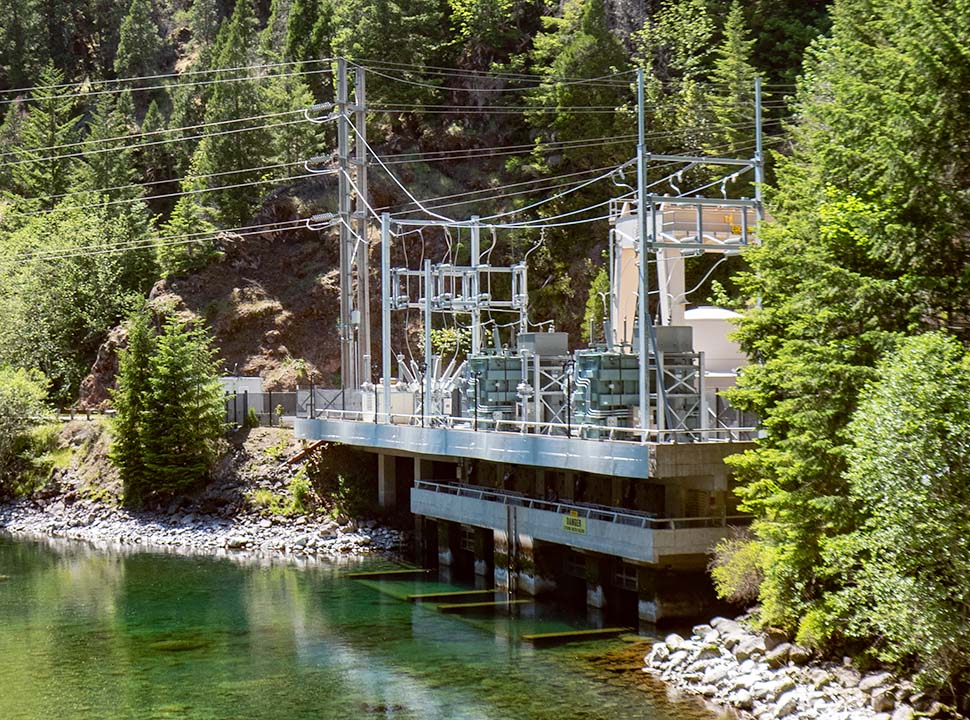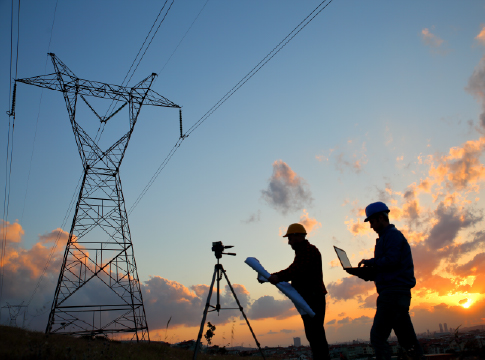Related News
Related News
-
2024 Public Power Week Poster Contest
To celebrate Public Power Week, EWEB is held our annual poster contest for fifth graders in our service area. Help us choose the winners.
Find Out More -
Smart meters make UO move-in easier
Automatic move-in service order processing makes signing up for electric service easy for UO students and the entire Eugene community, while keeping utility vehicles off the road and lowering carbon emissions.
Find Out More -
EWEB customers achieve remarkable results in environmental stewardship through EWEB's Lead Green programs
Subscribers of EWEB's Lead Green programs helped reduce carbon emissions in 2023 by 730 metric tons of CO2e.
Find Out More -
EWEB prepares to re-energize the new Currin Substation
The rebuilt substation will increase load capacity, improve power reliability, and incorporate seismic resiliency to ensure service to our community for generations.
Find Out More -
EWEB, SUB and RWD join forces at Lane County Fair to distribute water to fairgoers
The Eugene Water & Electric Board, Springfield Utility Board and Rainbow Water District are teaming up for the 9th year to provide fairgoers with clean, cold free water.
Find Out More -
Demand for EWEB electricity during heatwave nearly broke all-time summer record
Climate-driven weather extremes, home electrification, high-tech manufacturing and data centers will cause electricity demand to surge across the Pacific Northwest.
Find Out More -
EWEB explores rate increases to cover rising costs and to modernize infrastructure
Amid rising inflation and other challenges, rate increases are necessary to maintain reliable utility services and fund critical investments in Eugene’s water and electric infrastructure.
Find Out More -
EWEB prepares for rising energy demand as weekend heat wave arrives
Electricity supply is sufficient for now, but new supplies will be necessary in the years ahead to keep pace.
Find Out More -
EWEB preparing for expected surge in electric vehicles
Electric vehicle (EV) sales are poised to skyrocket in the years ahead as technology improves, more models hit the market, prices fall and regulations limit the sale of gas-powered vehicles. And EWEB is preparing for this surge.
Find Out More -
Community members can test out climate-friendly e-bikes at E-Bike Expo on Saturday
EWEB encourages Eugene residents to ride into summer on clean, accessible e-bikes, with a $300 e-bike rebate.
Find Out More -
EWEB invests in satellite-based forestry analytics for vegetation management
EWEB maintains over 1,300 miles of overhead transmission and distribution lines. To aid crews in identifying hazardous vegetation growth in a sometimes heavily forested service territory, EWEB is utilizing a new satellite-based forestry analytics software called Overstory.
Find Out More -
Tips to stay cool while saving money this summer
June is quickly approaching, and that means summer weather is just around the corner. Before you turn up the air conditioning and see an increase in your utility bill, try these tips to prepare your home for warmer weather to keep your home cool.
Find Out More -
EWEB offering additional energy efficiency supplement to qualified customers
Current EWEB residential electric customers may qualify to double their energy efficiency rebates with a limited time supplement.
Find Out More -
EWEB opens application for 2024 Electric Mobility Community Grants
Grant awards of up to $30,000 to cover costs associated with electric mobility projects.
Find Out More -
Upgrades to Eugene's downtown electric network continue
You may have noticed construction this week on the corner of 7th and Pearl Street. That’s because crews replaced a corroded, aging vault with an innovative, new Voltek vault. The Voltek design allows for the new infrastructure to be built inside of the existing aging vault. We’re able to install the new vault while the cables are still energized, minimizing disruption to customers and traffic while cutting construction time in half.
Find Out More - Show More
Planning for a Future of Reliable, Affordable, Environmentally Responsible Energy
September 01, 2023 • Aaron Orlowski, EWEB Communications

This article was originally published in NWPPA’s Aug. 2023 Bulletin.
A decade ago, when EWEB last published an integrated resource plan (IRP), it was possible to commit to curb all future load growth through conservation and incentivizing customers to reduce demand.
Not so today.
As part of our IRP process, EWEB is forecasting that, under modest growth conditions, demand will start to rise in 2030 by 2% per year, due primarily to electric vehicle charging. We will need to acquire new resources, with leading options including supplementing our hydropower base with new wind farms and new utility-scale batteries, plus customer programs aimed at reducing overall load and shifting demand to off-peak times.
But this potential updated portfolio is effectively the minimum. More dramatic growth conditions are becoming increasingly likely. When EWEB examined the effects of quickly rising demand, the suggested resource mix changed substantially to include less universally popular resources that can generate energy on demand with low or zero carbon emissions, such as biomass cogeneration and small modular nuclear reactors (SMRs).
As Oregon’s largest publicly owned electric utility serving about 200,000 people in the Eugene area, EWEB is a leader in providing reliable, low-cost environmentally friendly power, with a resource mix that is about 90% carbon-free. EWEB’s IRP analysis reflects the challenges facing public power utilities across the Northwest as we all grapple with rising energy demand, shrinking resource flexibility, and an ever more turbulent operating environment.
The climate is changing, with heat waves straining the grid and shifting precipitation patterns altering hydro- power operations. New energy markets are developing, and planning margins along with them. Political expectations are constricting the types of resources available. And community expectations and opinions are evolving in sometimes contradictory ways.
With analytical results from the 2023 IRP in hand, EWEB has identified a list of action items, none of which include pursuing a preferred resource portfolio. Instead, EWEB will prepare for the 2025 IRP – we will conduct an IRP every two years to adapt to changing conditions – by conducting a series of studies and continuing to engage in regional dialogues related to the 2028 Bonneville Power Administration contract and emerging markets.
“These IRP results reveal trade-os and challenges that we must overcome in the coming years. Not everyone has been pleased with the outcomes, which present more problems than solutions,” said EWEB General Manager Frank Lawson. “For the moment, we don’t need to procure any new resources. Our first needs arise in 2026, but that time is right around the corner. We need to be ready.”
EWEB’s forecasted demand mirrors the region’s.
Demand for electricity is rising across the Northwest. The Pacific Northwest Utilities Conference Committee, a trade group, forecasts that demand could rise nearly 25% in the next decade. Industrial loads – such as data centers and semiconductor manufacturing – make up the bulk of that.
PNUCC forecasts regional demand every year using data from utilities across the region, and their estimate of future demand has surged since the group’s 2022 estimate. Last year, PNUCC forecasted an average annual increase of 0.9%. This year, that number more than doubled to an annual average of 2.4%.
“This rate of projected growth we haven’t seen in decades. It’s quite remarkable,” PNUCC Executive Director Crystal Ball told the Oregon Capital Chronicle.
And many of the utilities reporting data haven’t factored in future load growth resulting from electrification and climate change, meaning that the projections are likely an undershoot. Without new investments in electricity generation, the region will face deficits of thousands of megawatts.
Electrification spurred by government incentives and regulations will prompt further rises in demand. Oregon, along with California and Washington, has banned the sale of new gas-powered cars starting in 2035. The 2022 Inflation Reduction Act is pushing down the cost of electric heat pumps. And statewide incentive programs are ramping up.
“There are resources in our region that have been retired, that will be retired, fossil fuels will need to be replaced with cleaner resources, with more wind and solar,” Ball added. “We’re going to have this steep step up in demand, and it’s not enough to just replace what’s retired, we need new resources to meet projected demand.”
As demand accelerates, EWEB’s possible resource mix shifts.
EWEB’s analysis arrived at similar conclusions.
With a modest level of growth, EWEB could meet future needs by continuing to rely on hydropower from BPA and supplementing that with new wind farms and new utility-scale batteries, plus conservation and demand response programs. But if demand rises more dramatically, those intermittent renewable resources won’t be sufficient.
Maintaining a reliable, affordable, and environmentally responsible electricity supply will require a diverse mix of resources from different categories that balance each other out.
“In the Northwest, hydropower is our foundation. Intermittent renewables like wind and solar oer carbon-free energy for a low price. We can’t control when those generate, but we can shape their generation a little with batteries and similar energy storage technologies,” said Brian Booth, EWEB’s chief energy resources officer. “There’s a final category, and it’s the hardest. We need low-carbon, on-demand energy sources with abundant fuel that we can control, so we can maintain reliability.”
Resources from each of the categories are not interchangeable.
“Full decarbonization – if we’re to do it affordable – demands that we get resources from each of those categories,” Booth said. “Only a diverse mix of resources will make sure that we have sufficient energy to heat homes and businesses on the coldest winter days.”
EWEB’s IRP analysis found that if demand for electricity grows quickly and if regional resource adequacy programs manifest, then the utility will need additional low- and zero-carbon, dispatchable, firm resources. The list of resources that meet those criteria today is short: biomass and small modular nuclear reactors.
In one analysis, EWEB assumed that the region-wide Western Resource Adequacy Program, which is currently in development, would require EWEB to acquire enough resources to have a 15% buffer above our average peak needs.
This planning reserve margin requirement is likely in the years ahead, as the WRAP moves forward with the goal of incentivizing utilities to invest in energy-generating resources that will help the region maintain a reliable grid and avoid rolling blackouts during peak demand. The details of the program are under development, but EWEB and other utilities will almost assuredly be obligated to meet at least a 15% buffer, and possibly more.
To help meet those reliability margins, the analysis suggested EWEB turn to biomass plants immediately and then to SMR by 2031, around the time it becomes available.
In another analysis, EWEB assumed that more customers would switch to electric heating and appliances. Currently, about 75% of customers in Eugene already use electric heat. The analysis examined what would happen if 50% of remaining residential buildings currently using natural gas heat switched to electric, causing peak demand to be 8% higher in 2042 than baseline projections. This is likely to happen because of electrification incentives and laws.
To meet this rising demand, the analysis suggested procuring SMR starting in 2030, when demand from electrification begins to ramp up, and adding in biomass a little later.
In a third analysis, EWEB looked at the impacts of higher transmission costs. High-voltage electric transmission lines bring energy from areas east of the Cascade Mountains rich in wind and solar to EWEB’s customers west of the Cascades. But transmission capacity is limited and dicult to build.
If transmission costs are twice as high, then energy from wind farms in Wyoming and Montana grows costlier. This makes local solar – assuming its transmission costs are very low – cost competitive, along with local biomass plants and SMR.
Regional studies show need for firm, zero-carbon power.
EWEB isn’t alone in finding that the path to a reliable, affordable, zero-carbon future likely runs through SMR – or some other future technology with similar operating characteristics.
A 2020 study by the consulting firm Energy + Environmental Economics (E3) illustrated the challenge of pursuing a zero-carbon grid without firm, dispatchable resources such as SMR. The study found that achieving a zero-carbon grid using solely renewables such as wind, solar, and hydropower paired with storage such as batteries would cost the Northwest $8 billion more per year than supplementing those resources with SMR.
This is because so much excess renewable capacity must be built to ensure reliability – if there are no firm dispatchable resources to complement it.
“As in past studies, E3 found that achieving deep emissions reductions from the electric sector is achievable at manageable cost, provided that firm capacity is available to avoid the infrequent but large electricity shortages that can occur on highly renewable grids,” E3 wrote in a March 2020 announcement of the study.
The E3 study was commissioned by Energy Northwest, the not-for-profit utility agency that operates the Columbia Generating Station, which is the Northwest’s sole commercial nuclear power plant. EWEB and other utilities across the Northwest get energy from the CGS via the Bonneville Power Administration. The study also found that continuing operations at CGS is a key element of an affordable, reliable, carbon-free grid.
The study was prompted by Washington’s 2019 Clean Energy Transformation Act, which calls for 100% clean electricity by 2045.
“That’s an ambitious and worthwhile goal, so we have to start planning today to ensure the people of Washington state have the right mix of energy sources tomorrow,” Brad Sawatzke, then-CEO of Energy Northwest, said in a January 2020 announcement. “And it’s our job to make sure that mix is not only reliable, but affordable.”
A different regional study conducted in 2022 by the Western Electricity Coordinating Council (WECC), which is the reliability coordinator for much of the Western U.S., had similar findings.
That study indicated that for the Western U.S. to achieve levels of clean energy above 90% both economically and efficiently there is a need for “other emerging clean and flexible energy resource technologies that do not pro- duce emissions” and for other “clean resource types with performance characteristics similar to that of gas-fired generation resources.”
The WECC study, however, did not suggest candidate resources that could fill that gap.
EWEB’s resource modeling designed to reflect community values.
EWEB launched the IRP process in early 2022 and spent the next 18 months developing 20-year forecasts and using modeling analysis software to assess various portfolios’ electricity sources that would best meet those needs at the best price.
The model weighed dozens of resources that included wind farms in multiple geographic regions, various types of solar energy, utility-scale batteries, conservation, demand response, hydropower, natural gas power plants, biomass facilities that burn woody material, and SMR.
EWEB embedded core community values of safety, reliability, affordability, environmental responsibility, equity, and transparency into the analysis process by establishing guardrails – constraints placed on the modeling software to keep it within specific bounds.
Every portfolio suggested by the model had to keep rates low. Every portfolio had to maintain reliability, even during peak consumption, which for EWEB occurs during the winter. And every portfolio had to be 95% carbon-free by 2030 in accordance with EWEB’s climate change policy.
A robust community engagement process reflected EWEB’s value of transparency.
EWEB staff presented to the Board of Commissioners seven times during public meetings, hosted half a dozen town halls and meetings on the IRP, and presented to various local neighborhood associations. They also authored and published five short-form briefings to untangle and explain thorny topics for the Commissioners and the public, such as why the model didn’t select solar, and why zero-carbon, on-demand resources are a vital part of a diverse resource mix.
EWEB also published multiple news stories and dozens of social media posts on the IRP. Three press releases and many other targeted media pitches prompted local and regional news outlets to feature EWEB’s IRP nearly 20 times, including on Oregon Public Broadcasting’s midday public aairs show, Think Out Loud, which is broad- cast across the state.
All this engagement resulted in community members submitting nearly 50 written comments, along with dozens of informal comments during Q&A sessions.
Moving forward with additional study.
With the modeling results published, EWEB is now moving to specific actions that we can accomplish in the next two to three years.
None of the actions involve procuring new generation resources. Instead, we will launch additional studies, continue regional dialogues, monitor emerging electricity markets and technologies, and refine our decision-making framework for when we do need to acquire additional electricity resources.
EWEB will continue to negotiate a new contract with BPA, which provides about 80% of our energy. We will study the potential to conserve energy in the community and the cost of administering those programs. We will assess the potential to shift electricity demand during the day to reduce peak energy use, because peak energy is more expensive and is associated with higher carbon emissions. And, lastly, we will prepare for our 2025 IRP.
The IRP process has surfaced challenges that utilities across the Northwest will need to confront in the years ahead, with our public power values as a guide.
“Twenty-four hours a day, 365 days a year, tomorrow, next year, next decade and next century—all of us in the utility industry know that our work of delivering reliable, affordable, and environmentally responsible energy never stops,” Lawson said. “With the world we operate in growingly more and more dynamic, our goal is to reassemble an electric generation portfolio based on all our values – safety, reliability, affordability, environmental responsibility, equity, and transparency.”
Related Programs
Here in Eugene, we are fortunate to have one of the cleanest power portfolios in the nation, with almost no electricity sourced from fossil fuels.
EWEB’s Integrated Resource Plan (IRP) will analyze possible energy resource portfolios with a goal of creating useful insights for long-term (20-year) electricity supply planning decisions.




